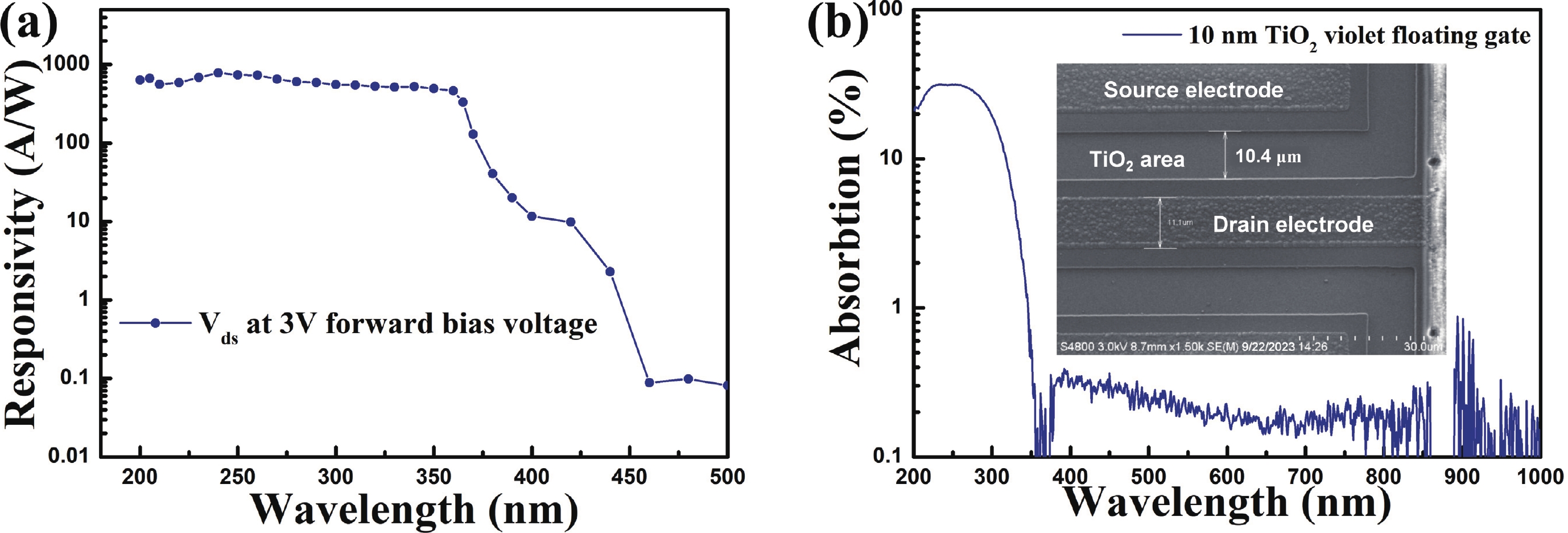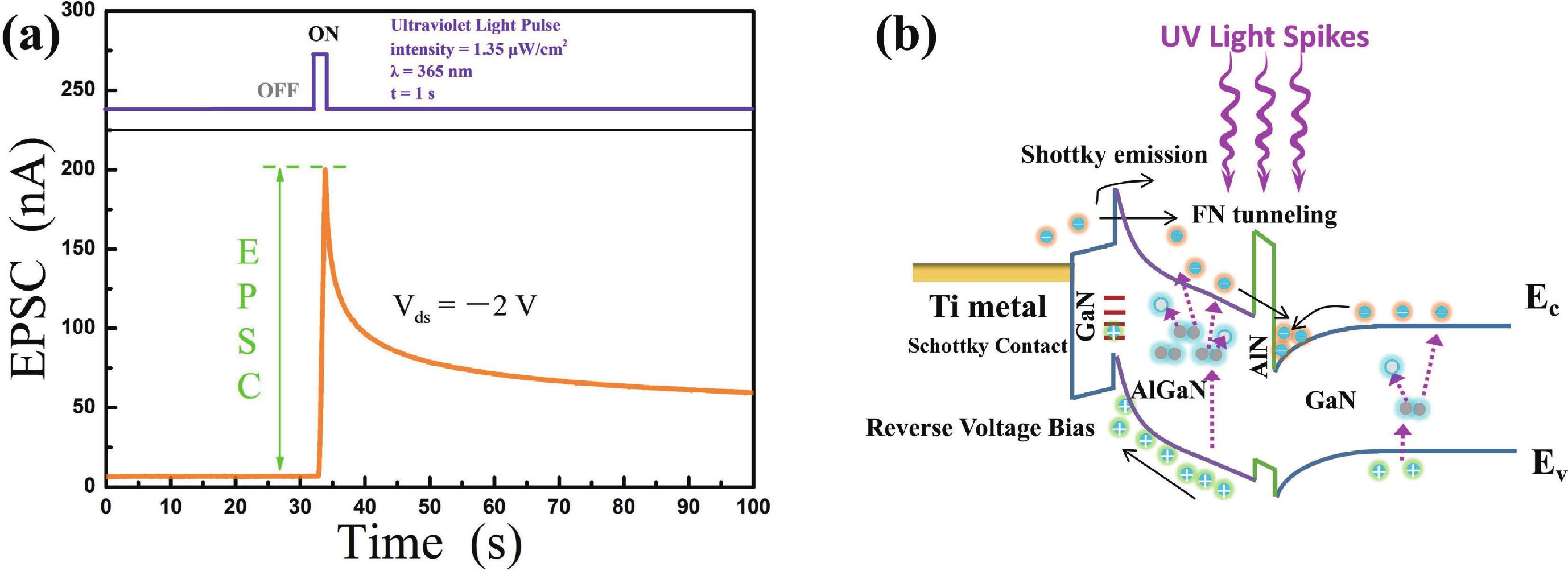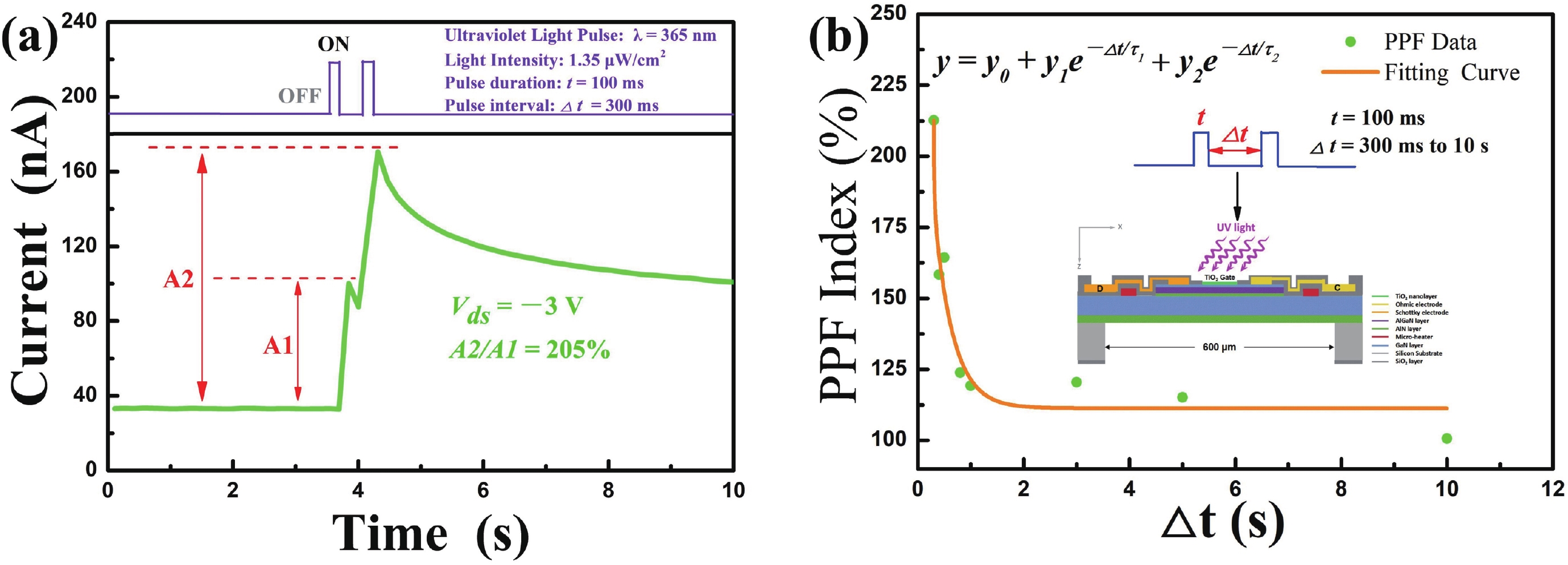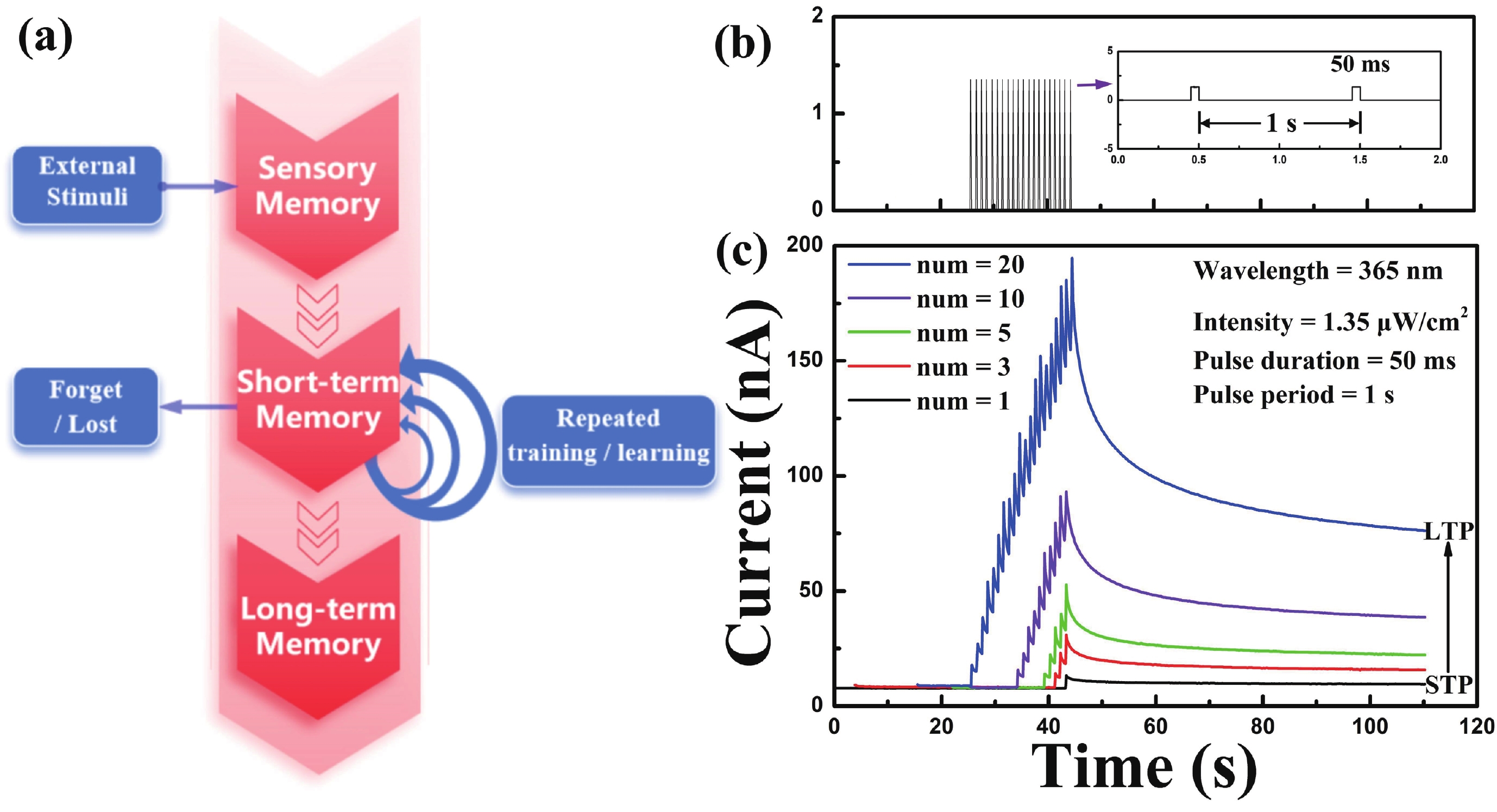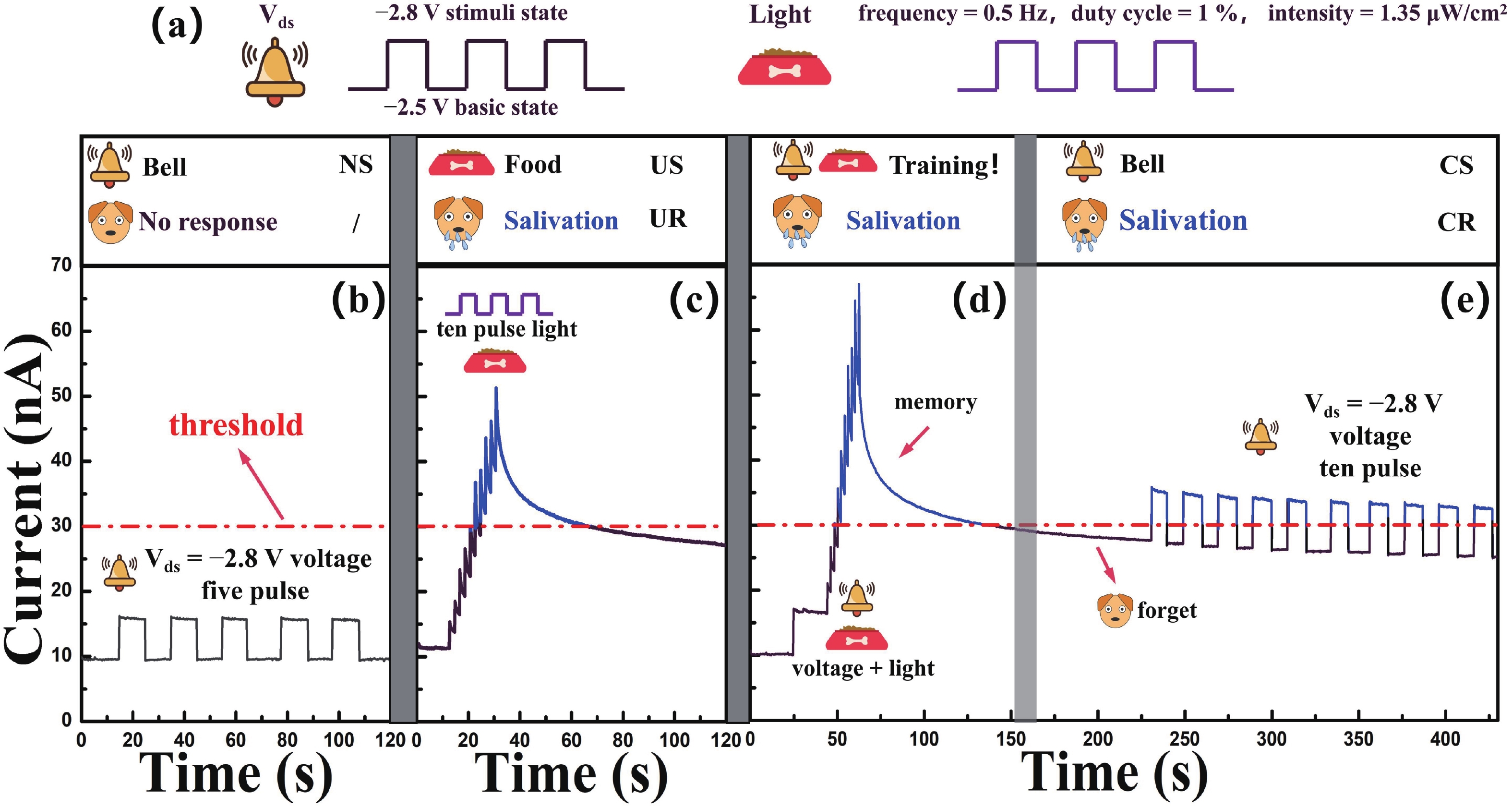| Citation: |
Teng Zhan, Jianwen Sun, Jin Lin, Banghong Zhang, Guanwan Liao, Zewen Liu, Junxi Wang, Jinmin Li, Xiaoyan Yi. Nanowatt-level optoelectronic GaN-based heterostructure artificial synaptic device for associative learning and neuromorphic computing[J]. Journal of Semiconductors, 2025, 46(2): 022404. doi: 10.1088/1674-4926/24080049
****
T Zhan, J W Sun, J Lin, B H Zhang, G W Liao, Z W Liu, J X Wang, J M Li, and X Y Yi, Nanowatt-level optoelectronic GaN-based heterostructure artificial synaptic device for associative learning and neuromorphic computing[J]. J. Semicond., 2025, 46(2), 022404 doi: 10.1088/1674-4926/24080049
|
Nanowatt-level optoelectronic GaN-based heterostructure artificial synaptic device for associative learning and neuromorphic computing
DOI: 10.1088/1674-4926/24080049
CSTR: 32376.14.1674-4926.24080049
More Information-
Abstract
In recent years, research focusing on synaptic device based on phototransistors has provided a new method for associative learning and neuromorphic computing. A TiO2/AlGaN/GaN heterostructure-based synaptic phototransistor is fabricated and measured, integrating a TiO2 nanolayer gate and a two-dimensional electron gas (2DEG) channel to mimic the synaptic weight and the synaptic cleft, respectively. The maximum drain to source current is 10 nA, while the device is driven at a reverse bias not exceeding −2.5 V. A excitatory postsynaptic current (EPSC) of 200 nA can be triggered by a 365 nm UVA light spike with the duration of 1 s at light intensity of 1.35 μW∙cm−2. Multiple synaptic neuromorphic functions, including EPSC, short-term/long-term plasticity (STP/LTP) and paried-pulse facilitation (PPF), are effectively mimicked by our GaN-based heterostructure synaptic device. In the typical Pavlov’s dog experiment, we demonstrate that the device can achieve "retraining" process to extend memory time through enhancing the intensity of synaptic weight, which is similar to the working mechanism of human brain.-
Keywords:
- GaN,
- heterostructure,
- neuromorphic,
- synaptic,
- optoelectronic,
- phototransisitor,
- pavlov
-
References
[1] Drachman D A. Do we have brain to spare? Neurology, 2005, 64, 2004 doi: 10.1212/01.WNL.0000166914.38327.BB[2] Borst J G G, Sakmann B. Calcium influx and transmitter release in a fast CNS synapse. Nature, 1996, 383, 431 doi: 10.1038/383431a0[3] Cohen-Cory S. The developing synapse: construction and modulation of synaptic structures and circuits. Science, 2002, 298, 770 doi: 10.1126/science.1075510[4] Wang Y, Yin L, Huang W, et al. Optoelectronic synaptic devices for neuromorphic computing. Adv Intell Syst, 2021, 3, 2000099 doi: 10.1002/aisy.202000099[5] Han H, Yu H Y, Wei H H, et al. Recent progress in three-terminal artiffcial synapses: From device to system. Small, 2019, 15, 1900695 doi: 10.1002/smll.201900695[6] Hu L X, Yang J, Wang J R, et al. All-optically controlled memristor for optoelectronic neuromorphic computing. Adv Funct Mater, 2021, 31, 2005582 doi: 10.1002/adfm.202005582[7] Zheng J H, Du Y M, Dong Y J, et al. Fully light-modulated memristor based on ZnO/MoOx heterojunction for neuromorphic computing. Appl Phys Lett, 2024, 124, 133502 doi: 10.1063/5.0197199[8] Lu C, Meng J L, Song J R, et al. Self-rectifying all-optical modulated optoelectronic multistates memristor crossbar array for neuromorphic computing. Nano Lett, 2024, 24, 1667 doi: 10.1021/acs.nanolett.3c04358[9] Luo Z D, Xia X, Yang M M, et al. Artificial optoelectronic synapses based on ferroelectric field-effect enabled 2D transition metal dichalcogenide memristive transistors. ACS Nano, 2020, 14, 746 doi: 10.1021/acsnano.9b07687[10] Guo F, Song M L, Wong M C, et al. Multifunctional optoelectronic synapse based on ferroelectric van der waals heterostructure for emulating the entire human visual system. Adv Funct Mater, 2022, 32, 2108014 doi: 10.1002/adfm.202108014[11] He H K, Yang R, Zhou W, et al. Photonic potentiation and electric habituation in ultrathin memristive synapses based on monolayer MoS2. Small, 2018, 14, 1800079 doi: 10.1002/smll.201800079[12] Yu J R, Yang X X, Gao G Y, et al. Bioinspired mechano-photonic artificial synapse based on graphene/MoS2 heterostructure. Sci Adv, 2021, 7, eabd9117 doi: 10.1126/sciadv.abd9117[13] Zhang T, Guo X, Wang P, et al. High performance artificial visual perception and recognition with a plasmon-enhanced 2D material neural network. Nat Commun, 2024, 15, 2471 doi: 10.1038/s41467-024-46867-8[14] Sun J, Oh S, Choi Y, et al. Optoelectronic synapse based on IGZO-alkylated graphene oxide hybrid structure. Adv Funct Mater, 2018, 28, 1804397 doi: 10.1002/adfm.201804397[15] Dutta R, Naqi M, Cho Y, et al. Augmented optoelectronic quantum dot-enhanced heterogeneous IGZO-Te photodiode for artificial synaptic image processing applications. Adv Funct Mater, 2024, 34, 2315058 doi: 10.1002/adfm.202315058[16] Ma F M, Zhu Y B, Xu Z W, et al. Optoelectronic perovskite synapses for neuromorphic computing. Adv Funct Mater, 2020, 30, 1908901 doi: 10.1002/adfm.201908901[17] Feng S Y, Li J X, Feng Z T, et al. Dual-mode conversion of photodetector and neuromorphic vision sensor via bias voltage regulation on a single device. Adv Mater, 2023, 35, 2308090 doi: 10.1002/adma.202308090[18] Hua X Y, Zheng J Y, Han X, et al. Artifcial optoelectronic synapse with nanolayered GaN/AlN periodic structure for neuromorphic computing. ACS Appl Nano Mater, 2023, 6, 8461 doi: 10.1021/acsanm.3c00796[19] Liu X, Wang D H, Chen W, et al. Optoelectronic synapses with chemical-electric behaviors gallium nitride semiconductors for biorealistic neuromorphic functionality. Nat Commun, 2024, 15, 7671 doi: 10.1038/s41467-024-51194-z[20] Alquraishi W, Fu Y, Qiu W J, et al. Hybrid optoelectronic synaptic functionality realized with ion gel-modulated In2O3 phototransistors. Org Electron, 2019, 71, 72 doi: 10.1016/j.orgel.2019.05.015[21] Li Z B, Li M, Zhu T X, et al. Flexible printed ultraviolet-to-near-infrared broadband optoelectronic carbon nanotube synaptic transistors for fast and energy-efficient neuromorphic vision systems. Small Meth, 2024, 2400359 doi: 10.1002/smtd.202400359[22] Sun J W, Zhan T, Liu Z W, et al. Suspended tungsten trioxide (WO3) gate AlGaN/GaN heterostructure deep ultraviolet detectors with integrated micro-heater. Opt Express, 2019, 27, 36405 doi: 10.1364/OE.27.036405[23] Sun J W, Zhang S, Zhan T, et al. A high responsivity and controllable recovery ultraviolet detector based on a WO3 gate AlGaN/GaN heterostructure with an integrated micro-heater. J Mater Chem C, 2020, 8, 5409 doi: 10.1039/D0TC00553C[24] Sun J W, Zhan T, Sokolovskij R, et al. Enhanced sensitivity Pt/AlGaN/GaN heterostructure NO2 sensor using a two-step gate recess technique. IEEE Sens J, 2021, 21, 16475 doi: 10.1109/JSEN.2021.3082205[25] Zhan T, Sun J W, Feng T, et al. Electrical characteristics and photodetection mechanism of TiO2/AlGaN/GaN heterostructure-based ultraviolet detectors with a Schottky junction. J Mater Chem C, 2023, 11, 1704 doi: 10.1039/D2TC04491A[26] Yang C Y, Sun J W, Zhang Y L, et al. Construction of AlGaN/GaN high-electron-mobility transistor-based biosensor for ultrasensitive detection of SARS-CoV-2 spike proteins and virions. Biosens Bioelectron, 2024, 257, 116171 doi: 10.1016/j.bios.2024.116171[27] Kai C H, Wang Y, Liu X, et al. AlGaN/GaN-based optoelectronic synaptic devices for neuromorphic computing. Adv Optical Mater, 2023, 11, 2202105 doi: 10.1002/adom.202202105[28] Zhang G M, Yu H R, Shi Y M, et al. Flexible and low-voltage ITO synaptic transistors for biotic tactile sensing. Appl Phys Lett, 2023, 123, 023702 doi: 10.1063/5.0153082[29] Atkinson R C, Shiffrin R M. The psychology of learning and motivation: advances in research and theory. Academic Press, New York, 2003, 2, 89[30] Yu F, Zhu L Q, Xiao H, et al. Restickable Oxide neuromorphic transistors with spike-timing- dependent plasticity and pavlovian associative learning activities. Adv Funct Mater, 2018, 28, 1804025 doi: 10.1002/adfm.201804025[31] Ji X D, Paulsen B D, Chik G K K, et al. Mimicking associative learning using an ion-trapping non-volatile synaptic organic electrochemical transistor. Nat Commun, 2021, 12, 2480 doi: 10.1038/s41467-021-22680-5[32] Meng J L, Wang T Y, Chen L, et al. Energy-efficient fexible photoelectric device with 2D/0D hybrid structure for bio-inspired artificial heterosynapse application. Nano Energy, 2021, 83, 105815 doi: 10.1016/j.nanoen.2021.105815 -
Proportional views





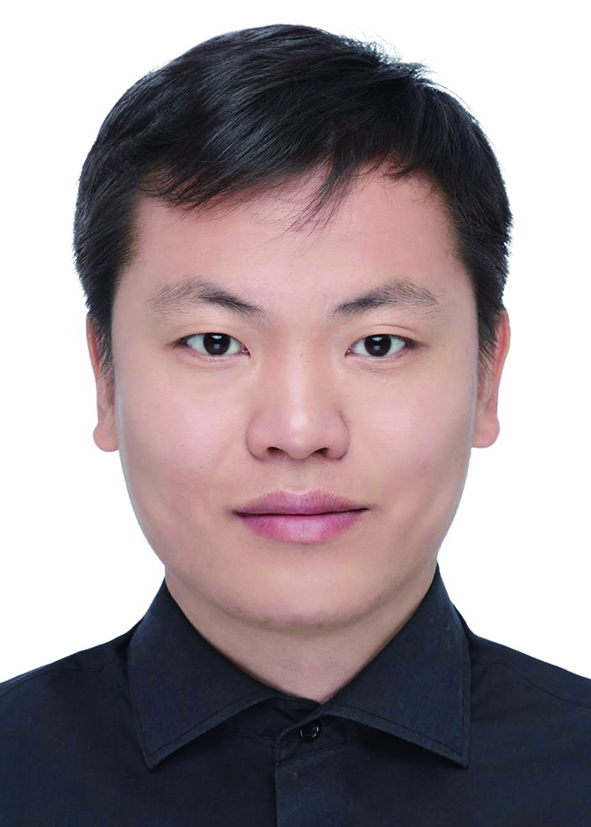 Teng Zhan is currently an assistant researcher at the Institute of Semiconductors, Chinese Academy of Sciences. His current research interests include GaN-based Micro-LED, ultraviolet detector, neuromorphic device and optoelectronic devices.
Teng Zhan is currently an assistant researcher at the Institute of Semiconductors, Chinese Academy of Sciences. His current research interests include GaN-based Micro-LED, ultraviolet detector, neuromorphic device and optoelectronic devices. Xiaoyan Yi is currently a researcher at the Institute of Semiconductors, Chinese Academy of Sciences. Her current research interests include GaN-based Micro-LED, Optogenetics, neuromorphic device and wide gap-band optoelectronic devices.
Xiaoyan Yi is currently a researcher at the Institute of Semiconductors, Chinese Academy of Sciences. Her current research interests include GaN-based Micro-LED, Optogenetics, neuromorphic device and wide gap-band optoelectronic devices.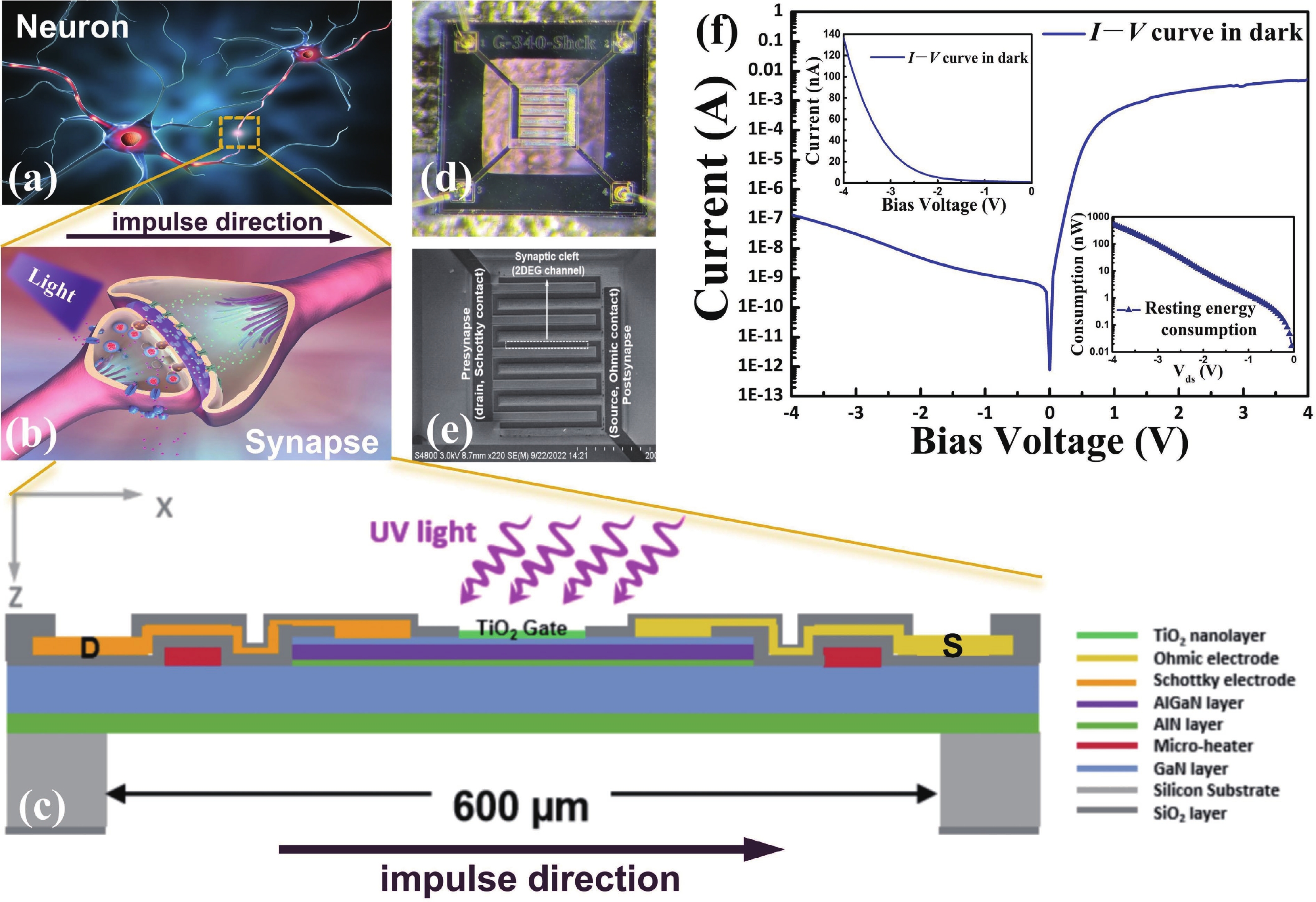
 DownLoad:
DownLoad:
